Review: System 100 - Behringer goes modular
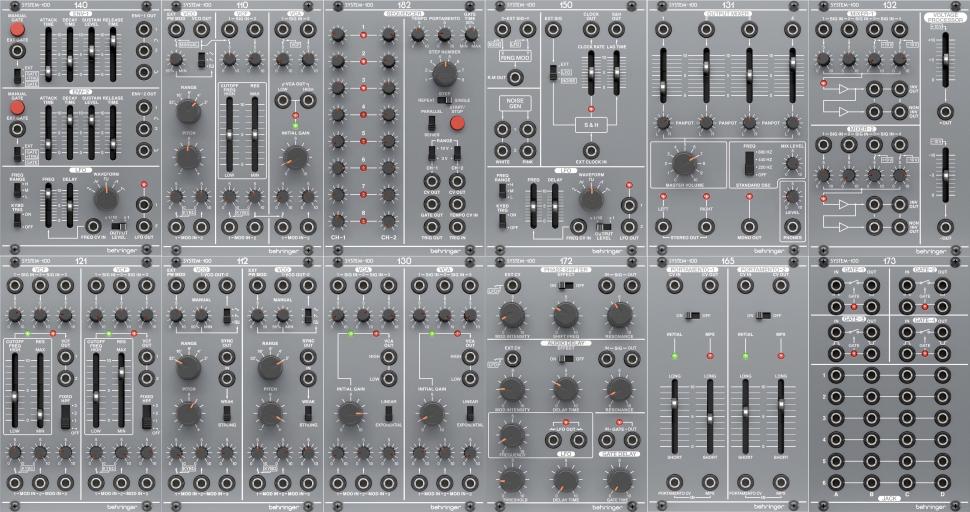
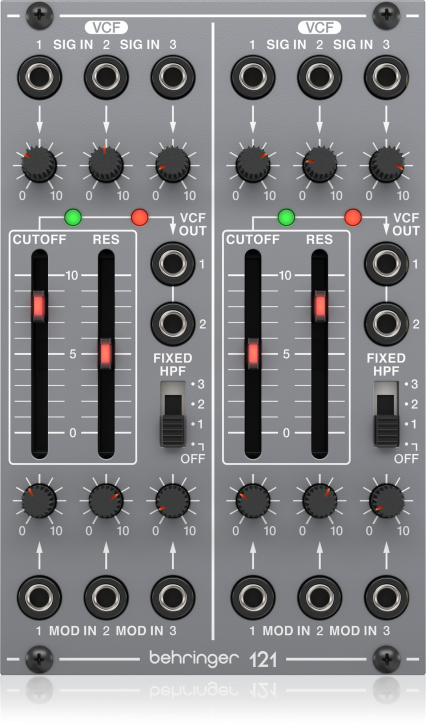
Module selection
We have put together a compact, yet flexible, good-sounding and, for Eurorack standards, very inexpensive system with a handful of modules. The modules are available together for just under 500 Euro, which is almost the price you pay for one module alone in Roland‘s replica System-500. Beginners have to add about 150 Euro for a suitable case and power supply, also in this respect Behringer is currently one of the cheapest suppliers on the market with the Eurorack 104. If no other equipment like an Arturia KeyStep is available, a MIDI-to-CV/Gate interface should also be bought in order to be able to control the system via the DAW or an external MIDI keyboard.
Installation is simple: each module includes a ribbon cable for the power supply, which is connected to the module and case with a plug. You then screw the module into the rack with the four screws that are also included.
Dual oscillator
The special feature of the System 100 is the dual structure of the modules, each of which takes up 16 HP of width in the rack. This means that each module offers double power: Two oscillators, two envelopes, two amplifiers. The basis of the sound generation is the Dual VCO 112.
It has two identically constructed but separately controllable analog oscillators with the waveforms square, sawtoo- th and triangle, between which you can choose with a small switch. Simultaneous sampling of all waveforms is not possib- le, but the pulse width is manually adjustable or can be modulated via a CV input (PWM). Even the raw waveforms are really good, with transparent and punchy sound they sound fresher and livelier than, for example, the plug-in emulations of Roland that we took for comparison.
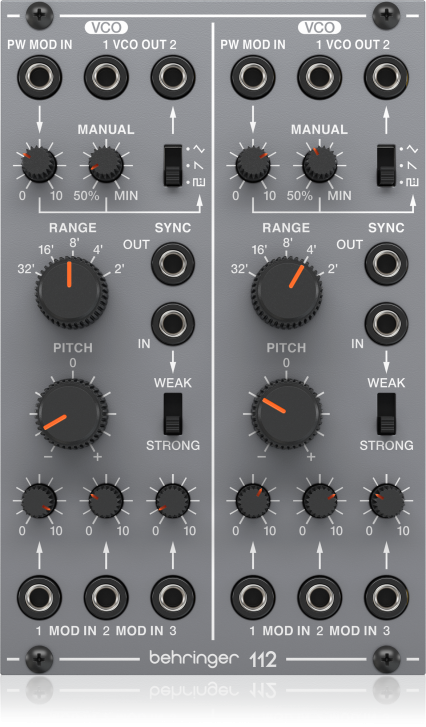
Sync and FM
Both oscillators have a sync input that can be switched between weak and strong. If you connect one of the two outputs of the left VCO to the sync input of the right VCO and set sync to strong, you will get the classic cutting, overtone-rich hard sync leads when modulating the frequency of VCO2 via an envelope or LFO. In the case of weak, the effect is somewhat attenua- ted. If, on the other hand, you connect the output of VCO1 directly to a modulation input of VCO2, the result of this frequency modulation is a wonderfully clear FM sound, which currently only analog technology can really do convincingly. In this area, emulations usually sound more static, often harsh and like mixed with digital artifacts. Here, the wide control range of the pitch with foot positions from 32‘ to 2‘ also pays off.
In addition, there is a knob for fine-tuning, although you need a bit of fingertip feeling to tune it cleanly to C.
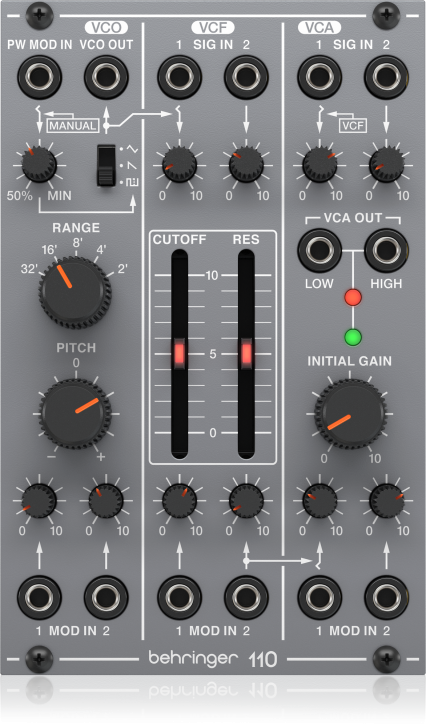
No internal cabling
Each oscillator has two identical outputs that you can use to play back the waveform currently selected for the VCO. In addition, there are three control inputs each with individual attenuators, so you can save an additional attenuator module. The first modulation input will usually be taken for pitch CV, i.e. the pitch of the note currently being played. At this point, a disadvantage of the Behringer system, e.g. compared to the Roland replica, becomes apparent: The modules are not „normalized“, so there is no internal pre-cabling. As a rule, you will control both oscillators in parallel with a pitch CV. But this also means that you have to connect this pitch source to the inputs of both oscillators, a connection to the modulation input of VCO1 does not automatically affect VCO2. So you need a multiple module or at least a stack cable to distribute the signal.
Stable tuning
The first delivery series still had massive problems with the octave purity and tuning stability, but Behringer seems to have successfully improved this. Our module, which is regularly purchased from specialist retailers, only showed a deviation of 5 cents over 5 octaves. That makes about 1 cent per octave and is thus hardly audible even for trained ears. Even with longer operation and the associated temperature increase, we could not determine any serious problems in the tuning; the module proved to be well calibrated.
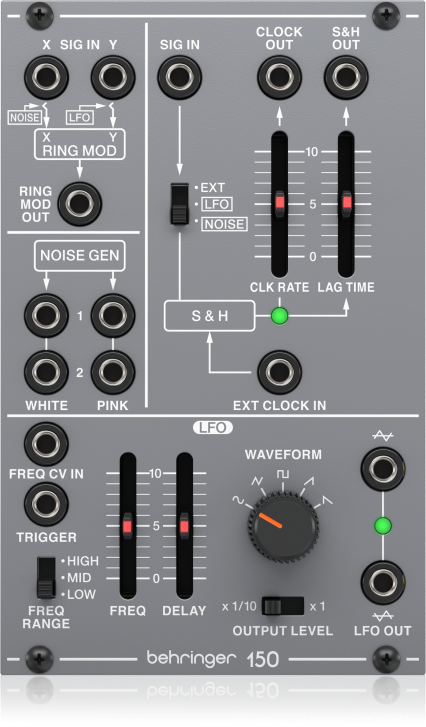
Dual filter
The next module is the Dual VCF 121, which offers two 24dB low-pass filters with adjustable resonance, each with an additional static highpass filter (switchable in three stages) to thin out the bass range. The filters have the typical Roland sound that makes classics like SH-101 or Juno so popular. They sound extremely musical and beautifully creamy, add a pleasant warmth to the input signal, and at high resonance values you can create wonderfully harmonic distortions. Typical SH101 rubber band basses are also possible. Even plug-ins that we ran through the filters as an alternative to the VCO module in the test clearly gained sonically from the dual filter, so that the module is also recommended as an inexpensive stereo filter bank. Three inputs are available for each filter. Since each of these inputs has its own volume control, you can control directly on the module how hot the filter should be driven by the oscillator signal. You also save an upstream mixer, since you can easily insert noise from the noise generator of the ring modulator module in adjustable volume in addition to the two VCO signals.
On the bottom side, as with the VCO module, you will find three modulation inputs with their own control for each filter. There is no pre-cabling here either. So if you want to run the system in stereo, you have to split the filter envelope and connect it to an input of both filter 1 and 2, which creates additional cable clutter. You can record the audio signal via two outputs per filter.
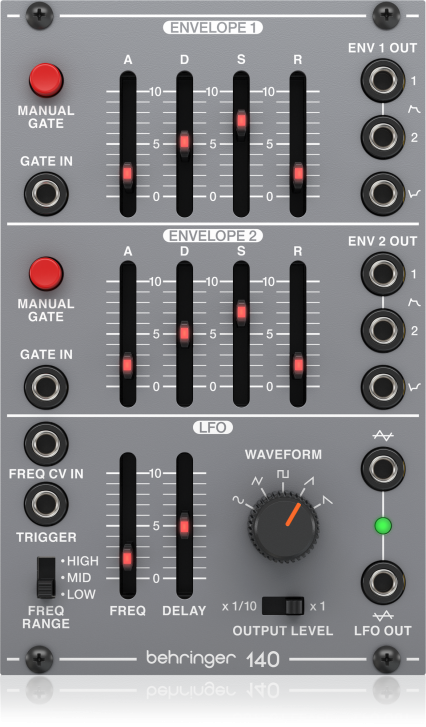
Dual amplifier
In our system, the filtered audio signal goes directly to the dual VCA 130. As with the dual filter, each of the two amplifier channels has three audio inputs and three modulation inputs for envelope, LFO (tremolo, amplitude modulation) or other modulation sources. Each channel can be switched individually between linear and exponential characteristic. The- oretically, the VCA can be used not only for audio signals, but also as a modulable attenuator for CV, but we didn‘t really succeed with this in the test. Initial gain determines the volume independently of the modulation.
This is not only interesting for drones or when looping external signals such as drum loops through the filter, but you can also use fast envelope modulation in exponential mode to emphasize the transients of a bass or percussion sound and add the „body“ with gain. Each VCA has two low or high volume outputs that feed the audio signal into a mixer, effects device, or directly into the sound card.
Punchy envelopes
The audio signal path is now complete. Depending on the wiring, a complete stereo sound is possible, with individual VCO, VCF and VCA per side. But without any modulation, the result is just a static sound. This is where the Dual Env/LFO module 140 comes into play. It offers two ADSR envelopes as well as an LFO. As with the filter, the parameters of the envelopes can be adjusted via small faders, and a built-in LED shows the current position even in poor lighting conditions. The envelope is triggered either manually with a button or usually via an incoming gate signal. Again, you need either two gate signals or a multiple/stack cable to trigger both envelopes. On the output side, things look better because each envelope has two outputs, which are used to modulate both VCF or VCA channels. In addition, there is an output for the inverted envelope. The envelope can sound really punchy and allows in combination with the filter module the SH-typical rubber band sounds, whereby in the lower control range of attack, due to the small faders, fingertip feeling is required. Even slowly rising pads are not a problem.
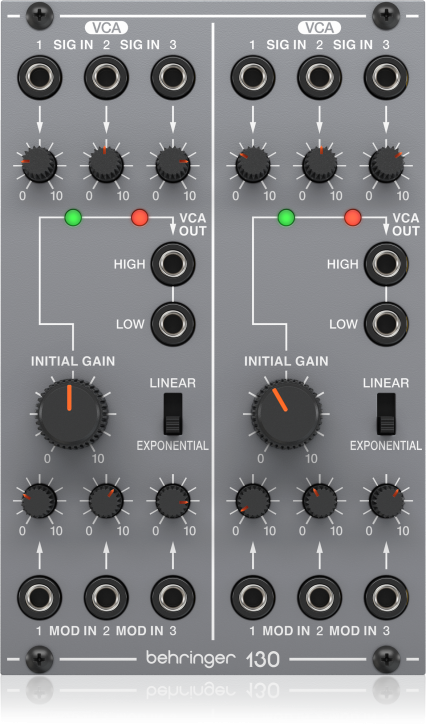
Flexible LFO
In addition to the two envelopes, the module contains a flexible LFO with five waveforms that can be recorded in parallel in normal and phase-inverted versions. In addition to typical applications such as vibrato and PWM, this also allows for exciting stereo modulations in conjunction with dual VCF and dual VCO. The LFO also has a trigger input to start the waveform via gate/trigger. And there is also a CV input to control the frequency. Since the speed can be switched in three steps into the audio range (0.5 to 30 Hz), it is theoretically also possible to use it as a third audible oscillator. Unfortunately, the frequency input is not octave pure, similar to the Behringer Crave, so that an octave played on the keyboard is only 10-11 semitones for the LFO.
Ring modulation & more
For experimental stuff we added the Ringmod/ Noise/S&H/LFO module. The ring modulator has two inputs, one of which is pre-wired to the noise generator and the other to the LFO. If you connect the two oscillators of the Dual VCO to the two inputs, preferably in combination with sync or duophonic control, you get weird sounds in the most beautiful Arp Odyssey style. Also integrated is a sample & hold generator with freely adjustable speed or speed that can be synchronized via clock input as well as adjustable lag time for smooth transitions between the random values. It provides exciting filter modulations that are reminiscent of Vince Clarke, or are great for sloping lines and sci-fi effects with pitch modulation. The noise generator has four outputs, two for white and two for pink noise (better suited for deep percussive sounds). The LFO is completely the same as the one built into the envelope module.
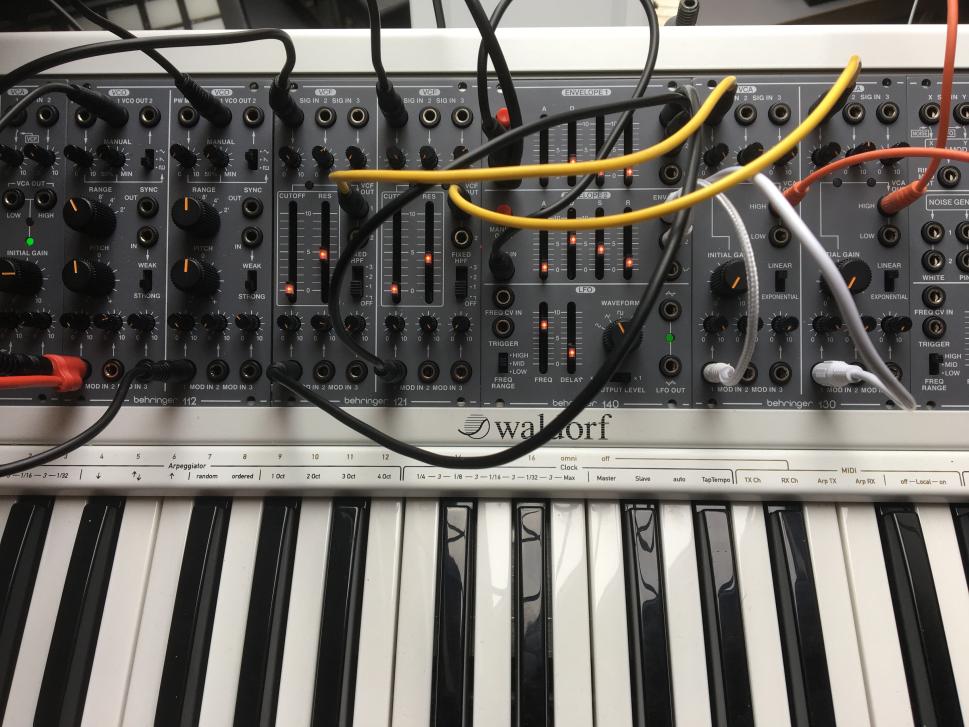
Waldorf kb37
For the test, we built the modules into a kb37 from Waldorf, which turned out to be the perfect partner. Due to the direct connection with a good Fatar keyboard and arpeggiator as well as the possibility of modulating the volume, filter frequency, LFO speed or pitch via touch dynamics, aftertouch and modulation wheel, we were able to play the System 100 dynamically like a real instrument without additional hardware. The kb37 also supports duophonic playing, so you can play two keys at the same time and thus controlling the two VCOs separately. And on top of that, the whole thing looks really fancy - at least until you get to the cabling. Because as already mentioned, nothing is pre-wired on the dual modules and you need to plug a lot of cables for a duophonic stereo sound. After that it becomes relatively difficult to access the small controls for adjusting the modulation strengths. The faders are not necessarily huge either. But they have the advantage that, for example, the frequencies of both filters can be adjusted simultaneously with only one hand.
Combi module
If you can do without the sync option and a few inputs and outputs, the VCO/VCFVCA 110 combo module is an alternative. It combines oscillator, filter and amplifier on 16HP width, where the signal path VCO→VCF→VCA is already internally connected, but can be split by plugging cables into the respective sockets if required. The modulation input for the filter is also automatically shared with the VCA. With two of these combination modules and an envelope module, you already have a complete entry-level system with two independent stereo channels, which is already functional with a handful of patch cables.
Verdict
After a few semi-modular synthesizers like Neutron and Crave, Behringer now also wants to get involved in the Eurorack world. And the entry with the System 100 was more than successful. The modules are solidly made, offer many options, are very cheap for Eurorack conditions and most importantly: they sound excellent. Powerful, transparent oscillators with a very good basic sound and convincing sync and FM sounds meet an extremely musical filter in the classic Roland style. The ring modulator brings weird, but never unpleasant sound alternatives. The flexible LFO ensure liveliness, especially with stereo sounds, for which the system is predestined due to its dual structure.
Since Behringer has accommodated a large number of options in a small space and, apart from the combination module, has not made any internal pre-cabling, you have to buy the flexibility with relatively extensive cabling in a small space, which at the expense of usability.
Want more? Get more!



Subscribe to the digital edition of BEAT Magazine via Plugins-Samples.com and get more gear, in-depth workshops, reviews and 11 GB exclusive plugins and new sounds with every monthly issue!
Subscribe to Beat Magazine for only 4.99€ per month
